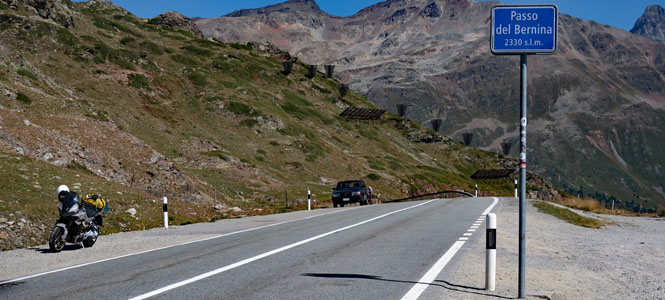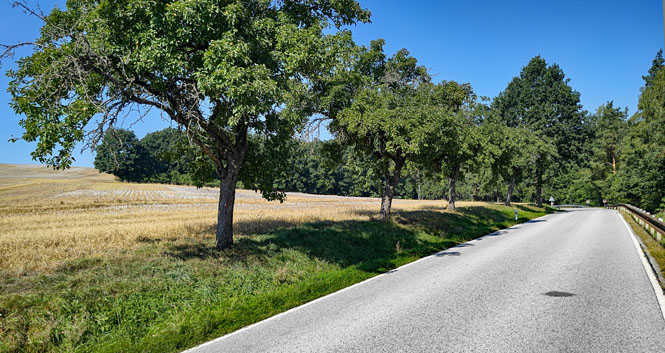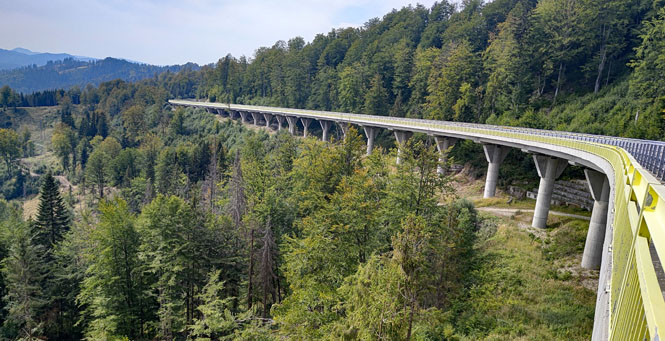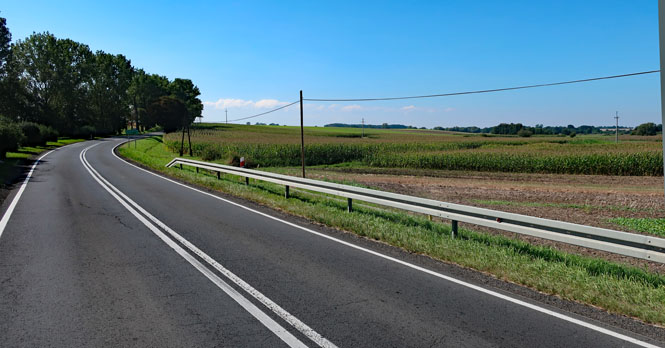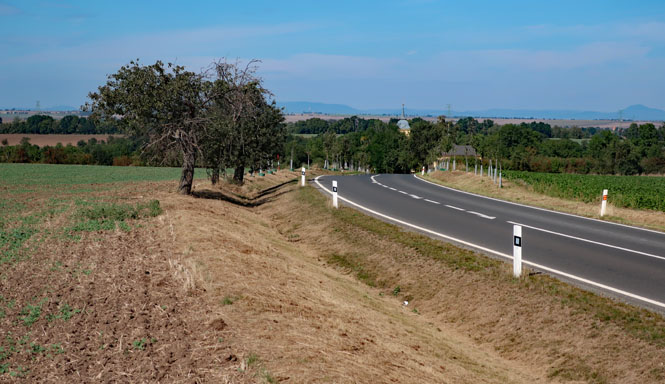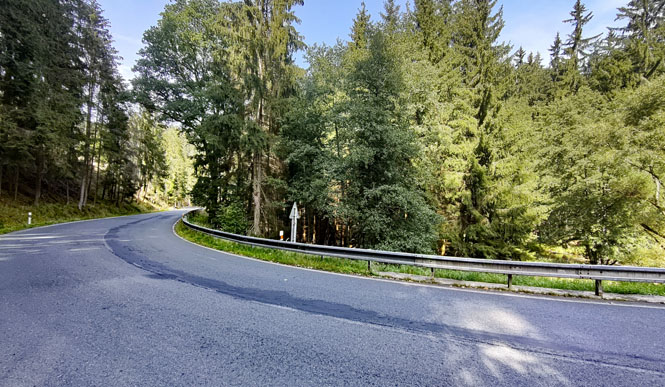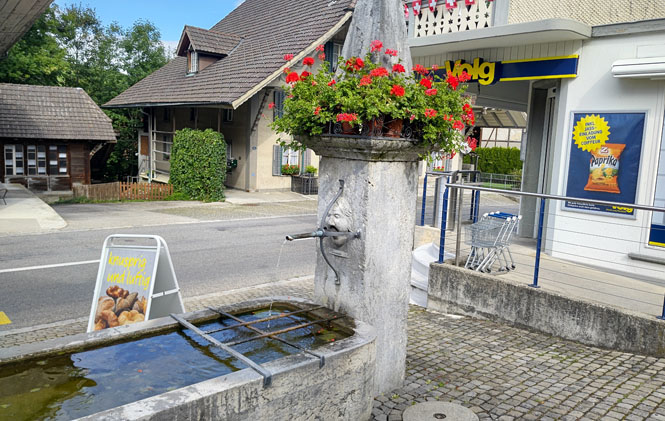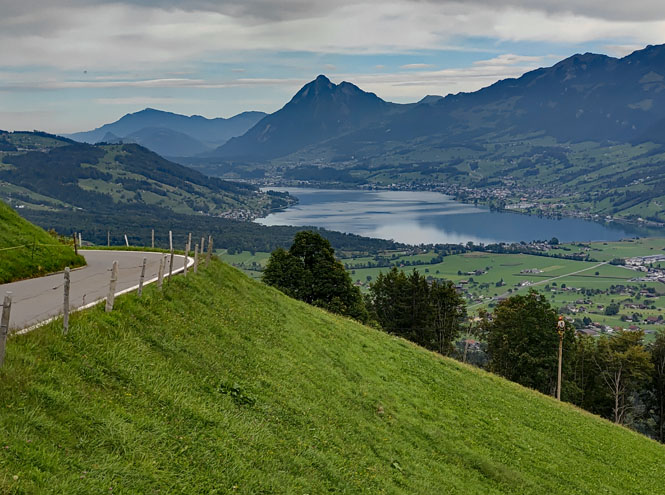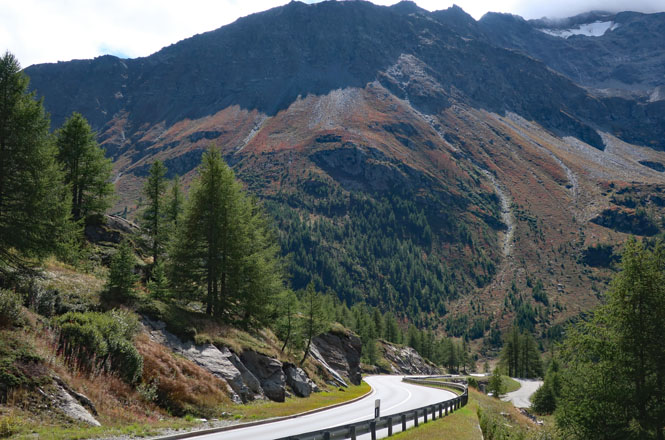






September, 2023

Sunday |
Monday |
Tuesday |
Wednesday |
Thursday |
Friday |
Saturday |
| 3 September |
4 Kansas Chicago |
5 Malpensa Milano Lecco, Italy |
6 Lecco, Italy |
7 Mandello Pfunds, Austria |
8 Saalfelden, Austria |
9 Cesky Krumlov, Czechia |
| 10 Beneov, Czechia |
11 Zdar nad Savavou, Czechia |
12 Olomouc, Czechia |
13 Zakopane, Poland |
14 Zakopane, Poland |
15 Auschwitz Oswiecim, Poland |
16 Kudowa-Zdroj, Poland |
| 17 Karlovy Vary, Czechia |
18 Eichstatt, Germany |
19 Hettingen, Germany |
20 Beromunster, Switzerland |
21 Rougemont, Switzerland |
22 Mandello, Italy |
23 Milano, Italy |
| 24 Malpensa Chicago Kansas |
25 | 26 | 27 | 28 | 29 | 30 |
Last year's trip was a ride around the perimeter of France. For this ride, I wanted to head a different direction. I've always enjoyed riding in the Czech Republic (since 2016 known as Czechia), so that decided it.
 Europe Motorcycle Trip #24
Europe Motorcycle Trip #24
I'd not ever yet ridden north of Prague, so that much was decided, and I hadn't visited the ancestral villages where two of my great-grandparents were born in many years, so that set another point. Beyond, that, I would just watch the weather, and see where I'd end up.
I packed maps for Italy, Austria, Switzerland, Hungary, Slovakia, Czechia, Poland, and Germany--not figuring on going beyond those countries, but not really expecting to visit all of them, either.
 Kansas
Kansas
 Illinois
Illinois
The usual route has always been through Newark, New Jersey. But, thanks to the extended range of the B787, I can now fly a direct route from Chicago to Milan, which is tremendously better. The Newark airport has never been a favorite.
Approaching Chicago on my first leg from Kansas.
I've always liked the walkway to Terminal B--ethereal Gershwin playing while the overhead colors dance the full length of the long moving sidewalk.

The plane was late arriving, but now it has been cleaned, fueled and fully stocked with food and is being towed to the gate for the long flight to Italy.
Taxiing away from the O'Hare terminal. When I next wake up, I'll be in Italy.
 Italy
Italy
Arriving at Malpensa Airport, walking down the glass-sided bridge to the terminal, through passport-check and then to the largely empty baggage claim area. Last year, difficulties with my riding suit meant that I had to buy a new (BMW) suit in France. I left that new suit in Mandello del Lario (and sent the faulty one back to Duluth, Minnesota for repairs), so that's one less bulky thing that I'll need to carry. l'm left with needing to only carry no more than would be allowable as carry-on, but I still chose to check the bag for this trip.

Malpensa is an hour from Milano, but there are frequent express trains, so getting there is easy enough. From Milano, I change trains to finish the trip to my destination of Lecco, which is on the right-hand southern leg of Lake Como.

Crossing the Adda River (which drains Lake Como), that's Lecco through the window of my train.
Lake Como is just across the street from my hotel
I've stayed at Hotel Alberi many times. It's an easy walk from the train station, and right on the lake.

The Lecco bell tower is seen on the right (below). I'd thought of taking one of the passenger ferries (which serve the entire lake), but the schedule didn't work for me. In any case, I always schedule two nights in Lecco to help my body adjust to the local clock, before starting the ride.
It's market day in Lecco.

The train to Mandello del Lario only takes ten or fifteen minutes, and leaves every hour.
I'll be riding a new 2023 Moto Guzzi V100 Mandello Marina Aviazione Navale. That's a bit of a mouthful: I think that just V100 Mandello is sufficient to identify it. This is a significantly new model for the company, with many changes from their previous models--the most obvious change being liquid cooling.
The orange SPOT device pings my latitude/longitude location to a satellite receiver every then minutes. These locations are then stored so that I can retrieve them, later (which is how I easily populated the map at the top of this report). This is more reliable than using a phone's tracking capability.
Preparing to leave from Agostini of Mandello Moto Guzzi.


 Switzerland
Switzerland
From Mandello, I headed up the Valtellina valley towards Tirano, Italy and then turned north towards Bernina Pass. I've done this many times, so didn't stop for any photographs. The morning is beautiful and the traffic is surprisingly light. The route over Bernina isn't as tightly twisty or aggressive as other passes over the Alps, but it's gorgeous and you have time to look around without worrying about plunging down the mountain or meeting an oncoming car in your lane.
A hundred gentle curves while riding along the edge of Engadin Valley.
Ardez, Switzerland and the ruins of Steinsberg Castle. You'll see such castles and towers throughout Switzerland, and nearly always you'll see them near passes.
From logs to lumber at the small mill near Martinsbruck, Switzerland.
 Austria
Austria
Pfunds, Austria and the view from my hotel room.
I'm often surprised by the quality of the hotels available in such small towns.


The old tower house anchors the south end of the wooden bridge over the Inn River. A carved statue of a saint is under the cover on the left side of the bridge.


The hotel restaurant is excellent. Yes, in Austria you are required to eat Apfelstrudel.

I made sure to stop in Faggen, Austria to purchase a vignette and check the tire pressure. This short-term sticker is good for ten days and allows me to ride certain major highways (motorways). While Austria (and other countries, including Switzerland) may not have regular tollbooths such as France and Italy have, that doesn't mean they don't charge to use their major roads.
The device on the far right (photo, below) is a portable air tank that you can carry from tire to tire of your car. It tops itself off with air pressure when you return it to its station near the fuel pumps. My dash (using readings from the tire TPS) said I had low tire pressure, but my own gauge said I was just fine. The dash was wrong--I ignored the occasional warning light for the rest of the trip.


The Tschirgant rises dramatically.
Scharnitz, Austria.
 Germany
Germany
The Deutsche Alpenstrafe is a scenic road across the southern Bavarian Mountains--this segment is in private hands. There's a man sitting in a chair at either end. Give him some money and you can be on your way. It's a beautiful road, but you need to be watchful for bicycles as they far outnumber all the cars and motorcycles.
The Isar River is the classic blue-green color of all rivers fed by mountain melt.
 Austria
Austria
Achen See. You can just see two ferries moving in opposite directions. Nearly all the lakes of the Alps have this wonderful color. I should note that these are real lakes, not reservoirs (which is the only type of lake that Kansas has).
The Inn River and Wiesing. In a few minutes, I'll be down there, and crossing the bridge over the river.
The Leogang Mountains. It's hard not to be swiveling your head left and right while riding through this valley.
Saalfelden, Austria. My hotel is straight ahead. Underground parking is across the street.



The Steinernes Meer above the town cemetery.


I've not had Risotto Verde, before; it's good. Aperol Spritz is practically as common as water (at least in the Tyrol and Bavaria).

I am heading generally east and north, somewhat aiming for Bohemia. But, mainly, I am staying off any road that looks like it might be busy.
Hallstatter See. This was a good place for a rest break.
Traunsee.
When you reach the northern edge of the Austrian Alps, that's it; no more Alps. Look behind you and you'll see mountains, rising up looking very formidable. Look north, and you see this.
Hellmonsödt, Austria - north of Linz. I took no photographs of my transit through Linz, and I would have avoided it entirely if I only knew how. Riding is miserable: lots of traffic, lots of crazy drivers. At the station, I stepped into the little cafe and pulled out my map to figure out where I should be going. I'm very near Bohemia and decisions need to be made. Which way to go...

This is Bad Leonfelden, Austria (just south of the Czech border), looking south. It's a bit too hazy to see the Alps from here.
Vyí Brod, Czechia on the Vitava River (called the Czech national river). I had some notion of following the Vitava River (the English language uses the German name of "Moldau", which is what the music by Bedřich Smetana is generally known by). But, it's a meandering river and doesn't seem to have roads that follow its path, so I dropped that idea.
Český Krumlov, Czechia.
The red-and-white "you are here" target (photo, below) also happens to be the location of my hotel. There's been a great deal of restoration work that was necessary after wars and years of neglect. But, it now is one of the major attractions of Bohemia.
Somehow I have this large accommodation, including two bedrooms, a kitchen and a dining room.

Walking around the town. This was once a royal city and it has a very long history.




The Vitava River makes a tight loop and the city is therefore virtually an island.
Walk across the multi-level bridge (below, left) and you can take a nice photograph of the town (above).

there are a few spillways on the river, but if you look to the side, you'll see a longer "slide" that rafts and other small boats can safely slide down. You get used to the occasional screams from people doing just that. Maybe it seems scary if you're on a boat.

Riding near Vesce, Czechia.
Rural Bohemia. I am riding towards Jetětice, which is the hometown of Jan (John), my great-grandfather. In 1874 he left Bohemia as a single man for a new life in Chicago.
It's land such as this that makes riding in Bohemia so enjoyable. I've been through this area several times (though not this road).
The road into Jetětice, Czechia from the west.
Jan Kalal
born: Jetětice, Bohemia 1859
died: Cuba, Illinois 1928
I doubt that Jetětice is any larger than when Jan lived here some 149 years ago.


The small church has a memorial stone listing the names of people killed in the 1914-1918 war, and the name Kalal is listed. Related? Probably.


A rural "farm experience" B&B is advertised, although I'm not at all sure that it's still in operation. The farm is known as the "Kalal Farm."
I talked with the people living here and learned that this farm (just on the edge of town) has always been known as the "Kalal Farm" and they've kept that name although they are not of that family. The name is not a common one, so it's entirely possible--perhaps even likely--that this house is where Jan (and many generations before him) once lived. Even if not, it's certain that other relations did.

Crossing the Vitava River--or at least a portion of the river that is now a reservoir.
More of rural Bohemia. Sometimes the roads I was on were not far removed from being a dirt road, but the pavement never vanished completely, even if things were a bit bumpy.
The old city of Beneov, Czechia. This is another small city that had a royal connection until things all fell apart after the first world war.
Everything I carry is in that yellow duffle bag (below, right). It has served me for many years and has never let a drop of water inside. That's my hotel (below, left).

Walking around Na Karlově in the evening.


These are the remains of a church destroyed by Hussites (who also burned the town). You'll need to read up on Central Europe history when travelling through Bohemia.





The Church of Saint Nicholas dates from the 1200s although these things are built and rebuilt through the centuries.



Back to the roads I enjoy.
My great-grandmother, Antonette Benda, left her hometown of Radětice, Bohemia in 1883, when she was just 19. She married Jan in 1885 in Chicago, which had a large Bohemian population. Eventually, she moved her entire family (but not including Jan) to central Montana, but that's another story and another trip).
Radětice, Czechia.
Antonette (Benda) Kalal
born: Radětice, Bohemia 1863
died: Roy, Montana 1956
This is the house that Antonette live in before leaving for America.
Walking around Radětice. I doubt things have changed all that much. It remains a small and fairly isolated town.


The sculptor of the war memorial (photo, below) is also named "Benda." A distant relation of mine? I've no idea.

Hrad Kámen (Kámen, Czechia).
Looking across Záhumenní rybnik (that's the name of the pond) to Bohdalov, Czechia. Kofola is quite popular around here.

Stopping at ďár nad Sázavou, Czechia for the night.
My hotel is at the top of these stairs on a level that is above another floor. My room is in the attic, which oddly was the case on several occasions on this trip--just keep your head down to avoid hitting the ceiling. Always, my laundry is done every evening.

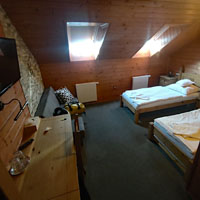
The Sázava River flows through the center of town.




Bransky rybnik (this region of Bohemia has lots of ponds)
The bridge over Strzsky potok.
Konventsky rybnik.
ďár was founded along with a Cistercian Monastery in the mid-1200s, but there have been a number of violent events in this area, and the town was ransacked and burned by Sweden in 1645.
The Poutní kostel svatého Jana Nepomuckého(Pilgrimage Church of St. John of Nepomuk) was built in 1720. The Bohemian architect (Jan Santini) had some interesting ideas.
There are plenty of steps to get to the top of the hora (hill).
An aerial view (taken from Google) gives a better idea of the shape.
I took the tour even though it was entirely in Czech; I mostly looked around.

It's a warm day, and I'm sitting down outside the walls of the church.
Riding through the hills of Bohemia.
Stínava, Czechia taking a break near a brook.

It's a pleasant bench, and I'm glad somebody took the time to put it here.
Olomouc, Czechia was once the capital of Moravia.
My hotel is the yellow building with the tunnel. I parked the motorcycle in the inner courtyard. Again, my room is in the attic.
I'll note that lodging in Bohemia (and Moravia) is far less expensive than nearby Austria or Germany. I've got two rooms and a full kitchen for a third the cost of a Holiday Inn Express in the U.S.--and the included breakfast is far better, too. Just keep your head down when walking near the walls.

The pinwheels spin in the breeze.
The historic city center remains.
The Holy Trinity Column was built in 1716 in gratitude for the end of the plague. It was built by Olomouc craftsmen.


I've always been nervous riding a motorcycle next to tram rails.

The Bečvou River near Teplice nad Bečvou, Czechia.
 Slovakia
Slovakia
I am riding through northern Slovakia and the Kremnica Mountains. It's a beautiful area that evidently isn't visited that much.
Bobrov, Slovakia. I've stopped here (near the border) to pull out my map and figure out my next step.

 Poland
Poland
The Tatras Mountains in the distance. These mark the northwest end of the larger Carpathian Mountains. There are few roads that go through the mountains, you've got to go around them.
Zakopane, Poland (in the old kingdom of Galicia) is a popular town for winter sports, but as you can see, it's still pretty popular in the fall, too.
Solid log buildings are very common. That's my hotel, and yes, I am in the attic.


The glass building (below) is a restaurant for people who like to be seen.

Below is the upper balcony of the dining room within my hotel.


Auschwitz-Birkenau Former German Nazi Concentration and Extermination Camp.
I've been near this part of Poland a few times already, but owing to weather or my schedule, I never stopped at Auschwitz. I made the effort on this trip.
There is no central museum of Auschwitz-Birkenau, no visitor center such as you might see at other historical places. It wouldn't make sense. Guided tours are run frequently and in many languages (and groups can be accommodated, as well).
For disheartenly reasons, security at the entrance is similar to what you'll see at an airport. And further, certain speech and behavior is prohibited. Photography is allowed, but there are small areas where that, too, is prohibited. I never saw anybody behave badly.

It's important to understand the development of Auschwitz. The walking tour first covers Auschwitz 1, and then moves to Auschwitz 2. The first camp was built on the location of an existing military base for the Polish Army and started as a forced labor camp (similar to the Dachau concentration camp), the second is far larger, and marked the transition of Auschwitz-Birkenau from a labor camp into a full extermination camp--a modern factory for killing.
Auschwitz-Birkenau is the largest of all the German Nazi concentration and extermination centers.

Our tour guide has a microphone around her neck, and all of us have been given headphones. There are many groups within hearing, so this method is ideal to avoid shouting and confusion from hearing a mixture of languages.
The gallows for hanging Rudolf Höss can be seen in the first photo (below) to the right of the guard tower. Höss was the commandant of the entire facility.

Initially during the existance of the camp, everybody entering was noted and photographed and detailed records were kept. Eventually, the numbers were so overwhelming that the practice was stopped--or at least they stopped taking photographs.

The photo (below, right) shows the place for executions. These were not ceremonial executions done in a military way--it's a place to fire a bullet, and move on to the next.

An enormous pile of eye-glasses followed by a pile of equipment used by survivors of the first world war.

Household pots and pans and the suitcases that people brought with them. The majority came from Poland, but endless trains brought people from all of Europe.

Shoes. Everything that was brought was taken from them immediately after the trains arrived. When they first boarded in their home country, they were told that they were being relocated to a remote town to separate them from the rest of Europe--they needed to pack. They were brought here, instead.
Empty, used canisters of Zyklon B.

The single gas chamber at Auschwitz 1 was something of a prototype for the much larger ones built at Auschwitz 2 (which each held three times more than this one).

The ovens are next to the large room where the pellets are dropped through the ceiling vents.

A special bus takes us to the far larger facility of Auschwitz 2.
I'm standing within the camp, looking to the entrance that trains from all over Europe would roll through. This was a very busy place. Those healthy and strong enough to be capable of becoming laborers in the nearby factories, were separated. The rest (including the children) were immediately taken to the chambers.
The buildings of Auschwitz 2 were not built to a high standard. Most of the wooden buildings have been lost, while some of the masonry remains. Expansion of the camp was continuing up until nearly the end of the war.
One of the animal cars (below, left) of the type that was used. Trains came from as far away as Greece (several days journey), so it's expected that when the doors were opened, many had already died.


The gas chambers were destroyed by the fleeing Germans as the advancing Soviet Army reached Auschwitz.

A memorial. The plaque is repeated in each of the languages of those who were killed here--over twenty languages.


Oświęcim, Poland. This is the actual Polish name for what the Germans called Auschwitz.
My GPS works the entire day on just two rechargeable AA batteries, but that's while using just the reflective screen--no back light. I rarely ride at night, so that's hardly ever a problem. But, this evening's late arrival to my downtown hotel after touring the camps was a bit more challenging.
This hotel was pretty much identical to what you might find at any other Hampton Inn in the United States. Kind of boring, but nice enough. There are not many choices in Oświęcim.

Sierakowice, Poland at the church of Saint Catherine of Alexandria. These old all-wood churches last hundreds of years. The underlying structure is made from large timber.
Near Kozielska, Poland. The hills and mountains of Bohemia and Moravia give way to vast prairies (now, farmland).
Wierzch, Poland.
Riding across southern Poland, and looking south towards the hills of Bohemia.
Kudowa-Zdrój, Poland. This a longtime spa town, with water that will apparently do wonderous things for you.
My hotel (bottom left) and room (bottom right, and with no decoration, whatsoever).

People came from all over Europe to recover from an illness or just to relax. I suppose they still do, and for the same reasons. It's a lovely town.


Running water for you to drink.

A list of curative powers of the water (below, right).

I used the translator in my phone to talk with the desk lady. I was confused about turning at the "lady-bug" to get to the parking area, and when I repeated her words back to her, she seemed baffled that she had said such a thing. But, when I saw this sign (below) I understood. Clearly, the translation back and forth wasn't making sense to either of us.
The guard dog was sounding quite fierce, but he was nice enough once I talked to him. When I put my helmet on, he reverted to being fierce, again.



 Czechia
Czechia
Lanov, Czechia, I'm back in Bohemia.
Hořice, Czecia. Time for a break and a chance to read the map. Where am I going, exactly?

The view looking out the window from my table.
Hobovice, Czechia is down in that low valley, next to a stream.
Hořovičky, Czechia for another look at the map while sitting next to this statue.
Joseph II was King of Bohemia (and the Holy Roman Empire) from 1780 to 1790 and was evidently quite popular in Bohemia as a reformer (he abolished serfdom among other good things).
Karlovy Vary, Czechia is one of the major spas in Europe. In English, it's known as Carlsbad (which is where the towns of that name in the U.S. get their name).
Hotels are everywhere. Parking is an entirely different thing. Luckliy, I'm on a motorcycle, which makes the thing a little easier.
My hotel (below).


The water in the Teplá River is full of minerals. Drink it; bathe in it. It will do you good. At least, that's what is said.

You might recognize this hotel from the Daniel Craig James Bond movie "Casino."
Teplá (means "warm") River - flows to Karlovy Vary,
Beautiful roads; a lovely area to ride.
Trstěnice, Czechia.
 Germany
Germany
Schedlhof, Germany. I am keeping well away from the Autobaun, or anything remotely like an autobaun.
Plößberg, Germany .
Eichstätt, Germany for the night.
I arrived in pouring rain. After wearing the overpants of this riding suit last year, I knew I needed to bring a pair of suspenders for this trip. Having a belt over a belt is a bother. So, I packed these durable Carhart suspenders for the trip.


These men continued working on the sidewalk pavers, even though the rain hardly stopped. My room is above a cafe and bakery.

The town has a very old (a thousand years) connection to the Benedictine Abbey of St. Walburga, which remains to this day.


Sad to think about it, but "witches" were once dunked in this river.

Stopping at Nersingen, Germany for benzin, kaffee and a hörnchen.
Heufelden, Germany
Riedlingen, Germany.
The Donau River--you'll know it as the Danube.
Hettingen, Germany for the night. This was one of the few days when I had a little trouble finding a place to stay. For whatever reason, things were full.
I stayed at Gasthof Adler.

The view of the church, just out my window. I quickly got used to the bells.

A walk around Hettingen.




Neuhausen ob Eck, Germany. I parked on the side of the road and walked up this hill...
...and in the distance, I can see the Swiss Alps. I am not too far from Switzerland.
 Switzerland
Switzerland
Thayngen, Switzerland. It's a very quiet border corssing. The flag is not flying, and nobody is here. I did stop in Schaffhausen for a Swiss vignette to allow me to ride the major roads. I didn't need it at the beginning of the trip (or at any rate, nobody noticed), but on the way back, I'd likely be on at least a couple of motorways. While Austria lets you buy a sticker good for ten days, Switzerland says you need to buy one for the entire year. Sigh...

Weiningen, Switzerland is the hometown of Henry Hug (spelled Haug at the time). Henry is the father of Julius and Julius is the father of my grandmother. Henry came to America in 1859, settling first in Utah, and then in 1879 the entire family moved to the northwest.
Henry Hug
born: Weiningen, Switzerland 1829
died: Elgin, Oregon 1902
I looked for things that were likely here when Henry lived here. The well, the church, the community building.




The speaker is labled "Haug" and possibly would connect me to a distant relative. I did not press it.


Hallwilersee. Sidenote: In 1938, Sir Malcom Campbell set a world record for a boat of 210.67 kmh on this lake.
Ermensee, Switzerland off on the side of the far hill.
Beromünster, Switzerland.
Once again, my room is in the attic. By now, I'm even ducking my head when my room is not in an attic. In this room, just ducking my head was not good enough.


St. Michael's monastery is in Beromünster.




I'm only a kilometer from the small town of Eriswil, Switzerland.
Eriswil, Switzerland is where Anna Muller was born and lived as a girl. Anna became the wife of Henry (we just met him). She left Switzerland for America around 1859, which is where she met Henry. Anna is my great-great-grandmother.
Anna (Muller) Hug
born: Eriswil, Switzerland 1836
died: Elgin, Oregon 1934
This fountain is mentioned in her written remembrances of life in Eriswil.

The small stream runs through the town. Anna would have known it, well.
A walk around Eriswil






The Panoramastrasse threads through the Emmental Alps. It's a wonderful road, but don't expect much space for oncoming cars to pass you, and do expect some pretty tight turns.
These mountains are not as high as the Alps you might know, but they're plenty scenic.
Glaubenbielenpass. When there is no center stripe, you'd best be wary approaching turns for oncoming cars. Buses and trucks are not allowed, so you shouldn't need to worry about them.
I am descending to Lake Sarnen. This is one of the nicest roads.
Crossing the Simme River.
Entering Rougemont, Switzerland as the rain begins to come down. Soon it will be pouring, but by then, I'll be dry and inside.
And yes, my room is in the attic. I'll try not to hit my head, but I seem to do it anyway (and too often).

Rüeblihorn (mountain) in the Bernese Alps as seen from Rougemont when the clouds clear a bit.
The church was built in the 11th century as a convent. It has been protestant since 1555, and its current appearance likely dates from then.

I appreciate that the tree has not been removed.

Dinner in the restaurant across the street. You will notice the dog under the table. That's a pretty common thing.


Montrose, Switzerland (on Lake Geneva). I've been on this motorway that follows the north shore of the lake many times; perhaps, on some future trip, I'll stop here longer than to just take a picture.
Stopping at the Coop Pronto Shop near Agarn, on the Rhône River. This full tank will take me the distance to Mandello del Lario, Italy.
You cannot be in Switzerland and not have a bottle of Rivella. It's a Swiss thing.

I'm making the long climb up the northern side of the Alps that separates Switzerland from Italy. I'm keeping an eye on the weather as it's forecast to be troublesome.
Riding through Simplonpass. This is one of the easier routes over the Swiss Alps.
Barralhouse (as it is known) at Simplonpass was built for a missionary society, but now is owned and still used by the Swiss Army (although there doesn't seem to be any sign that anybody is home).
 Italy
Italy
I really, really do not like stopping to pay the toll on the Autostrada. Some sections (in Lombardia) have electronic tolling, which requires you to log into an account and pay your toll. If you don't, they're find you eventually (as I've found out on a previous trip).
I am back in Mandello del Lario, Italy with my first stop (after unpacking at Agostini Moto Guzzi) at the gelato shop next to the lake. I've been riding in very heavy rain for the last two hours, so it's nice to be off the bike.
As always, I'm staying at Mamma Ciccia's B&B. It's the unquestioned (by me) best place to stay in Mandello.

Lake Como in the evening. "The most beautiful lake in the world"
Waiting for the southbound train in Mandello, with one last look at the Moto Guzzi factory: "you did a good job, guys."

My hotel in Milano is across the street from the Milano Central station. There are virtually no signs for it, and I twice walked by it.

The view of the station out my window. Nice; I am not in the attic this time.
The Milano Duomo on the plazza.

The original galleria...
...and inside.
This is a high-end shopping district for all sorts of things (from shoes to stoves). I bought nothing.




One of the cooks using a trash can (?) to shoo a bird out of the cafe. I was sitting outside, so the bird didn't bother me.


The view out the window the next morning from the breakfast room of my hotel.
I walked the short distance back to the station, and up those stairs...
...where I am waiting for the express train to the Malpensa Airport.

Mont Blanc from the airport window.
Waiting in the lounge and the boarding my flight that will take me back to Chicago where I'll catch the next flight home.

Crossing over the Italian Alps as we pass into France. The windows on the 787 have electric dimmers, which really messes with digital cameras. In color, this view is seen by the camera as bright green.
 Illinois
Illinois
Waiting in the lounge of Chicago's O'Hare for the latenight flight.
It has been a wonderful trip: many roads I'd never ridden (the red dots, below), and lots of new places to see.
The new Guzzi V100 Mandello did a great job, too, with the exception of a clunky and reluctant transmission that reminded me of the old 5-speed Moto Guzzi box. If that's corrected, the bike will be nearly perfect.












